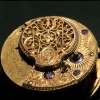Copying A Keyless Works Cover
-
Recently Browsing
- No registered users viewing this page.
-
Topics
-
Posts
-
By RichardHarris123 · Posted
Hello and welcome from Leeds, England. -
Hi Jersey Mo! I gotta ask, is this guide genuinely valid and useful? Someone in Watchuseek sent me this link https://www.vintagetimexwatches.com/servicing/#basic
-
You might like to see the contraption that I made for indexing on my Chinese lathe. This is a 4 inch rotary table with dividing plates that I attached to my lathe mandrel using a drawbar. It is completely manually operated. No electronics or computer needed. I have used it to make a 60 tooth clock wheel. I use a Sherline headstock on a vertical slide to drive the gear cutter. The wheel blank is mounted on an aluminium "superglue arbor." This is the modern equivalent of a shellac chuck, and allows the wheel to be centre bored, trued and the teeth cut in a single setup, ensuring that concentricity is maintained. The finished wheel after crossing. I have not tried to make small watch parts on this lathe. The runout on the mandrel bearings may be too high for that. I won't know unless I try.
-
By coreymsnow · Posted
Y'all are very helpful, I can't thank you enough for the insights.
-








Recommended Posts